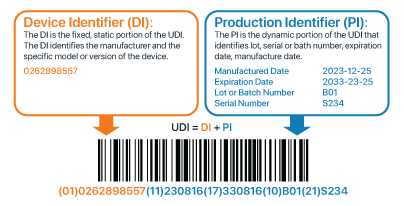You are here
Australian UDI requirements for sponsors and manufacturers
Sponsors of medical devices and in vitro diagnostic (IVD) devices supplied in Australia will be responsible for ensuring that their devices have:
- Labels on the device and all higher levels of packaging include a UDI that both people and machines can read (such as a barcode)
- The UDI and related data submitted to the TGA’s Australian UDI Database (AusUDID)
- The UDI is linked with the correct inclusion(s) in the Australian Register of Therapeutic Goods (ARTG)
- The UDI data is maintained while the device is in supply
- Where required, the UDI is direct marked on the device.
The unique identifier must be a combination of numbers, letters and symbols. It must also follow the specifications of a TGA recognised UDI Issuing Agency.
A unique identifier will have 2 parts:
- UDI-Device Identifier (UDI-DI) - identifies the model of medical device.
The UDI-DI is used as the “access key” to information stored in the AusUDID. It will be used for device related information such as adverse events and recalls. Examples of the UDI-DI include:- GS1 GTIN (Global Trade Item Number)
- HIBC-UPN (Universal Product Number)
- ICCBBA ISBT 128-PPIC (Processor Product Identification Code).
- UDI-Production Identifier (UDI-PI) - identifies the production specific information such as the production run of the device.
This could include a batch number, lot number or expiry date. The UDI-PI is present on the device but not stored in the Australian UDI Database (AusUDID). If applicable, the UDI-PI will be used for device related information such as adverse events and recalls.

Devices to meet UDI requirements
Medical devices and IVD devices supplied in Australia must comply with Australia’s UDI requirements, unless otherwise exempt. Device compliance will be based on device classification.
UDI requirements will apply to medical devices and IVDs that fall into these categories:
Medical device classes
- Class III
- Class IIb
- Class IIa
- Class Is – supplied sterile
IVD classes
- Class 4
- Class 3
- Class 2
- Class 1 categorised as:
- Instrument/analyser (GMDN Collective Term 943)
- Software (GMDN Collective Term 944)
Devices exempt
Medical devices and IVDs that are exempt from inclusion in the ARTG under Schedule 4 of the Therapeutic Goods Regulations 1990 will not be required to comply with UDI requirements. For example, medical devices that are:
- export only
- custom-made
- patient matched with a volume of 5 or less supplied each financial year
- exempt under Special Access Scheme (SAS) or Authorised Prescriber Scheme (APS)
- Class 1, 2 and 3 in-house IVDs.
While these devices are exempt from complying with UDI requirements, sponsors can voluntarily choose to meet the UDI requirements.
Compliance time frame
Mandatory compliance will be progressively phased by device classification. We will start with high-risk and implantable medical devices, followed by lower risk class devices over later years.
From the date the UDI regulations take effect, sponsors can choose to comply voluntarily. Mandatory compliance will start at a minimum of 12 months after the regulations take effect.
Compliance dates are not set yet.
Getting a UDI
The TGA must recognise the Issuing Agency that assigns the UDI to ensure the UDI is unique.
The TGA recognises the following Issuing Agencies:
GS1 | |
Health Industry Business Communications Council (HIBCC) | |
The International Council for Commonality in Blood Banking Automation (ICCBBA) |
If you're interested in a UDI, contact your chosen Issuing Agency.
TGA fees or charges
No UDI fees will apply to uploading your UDI information or changing it.
Costs for ongoing management and maintenance of the Australian UDI Database are included in annual fees.
Existing devices
Device class | Manufactured before compliance date? | Transition period |
|---|---|---|
Class III | Yes | 3-year transition period from compliance date before they must meet UDI labelling and data provision requirements. |
Class IIb | Yes | 3-year transition period from compliance date before they must meet UDI labelling and data provision requirements. |
All other classes | Yes | Exempt for the lifetime of the device. |
Devices requiring direct marking | Yes | Exempt from direct marking for the lifetime of the device. |
Compliance dates for these devices will be advised when the UDI regulations take effect.
If any existing device needs to be relabelled or remanufactured after their original supply date, they must meet UDI labelling and data provision requirements at the date of relabelling.
Exported devices
Medical devices or IVD devices that are:
- intended for export only from Australia
- strictly not for supply in Australia
will not need to comply with the Australian UDI requirements.
They may however need to meet UDI requirements of the country they are supplied to.
Re-registration or re-certification
Re-registration or re-certification will not be required when medical device labelling and other supporting documents are amended to meet the UDI requirements.
Essential Principles
UDI requirements, including labelling and provision of UDI data to the AusUDID will be part of the Essential Principles.
UDI requirements will not override the existing requirements of the Essential Principles in the Medical Device Regulations. It will not override the requirement to provide patient information materials.
Consent to supply
If you can’t meet the UDI requirements by the compliance date, you can request for consent to supply from the TGA.
You must lodge Consent to Supply applications and they must be approved prior to any applicable mandatory compliance dates.
Where Consent to Supply is granted for a device, the ongoing regulatory responsibilities of the sponsor remain. Among them are undertaking recall actions and reporting of adverse events.



